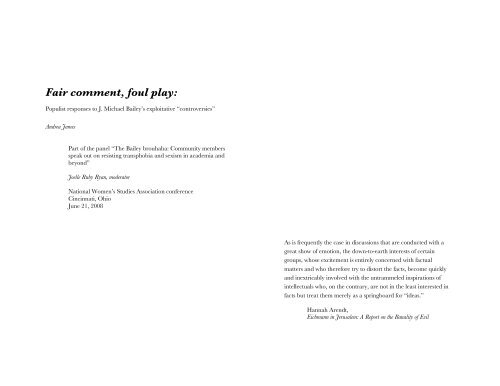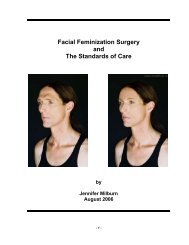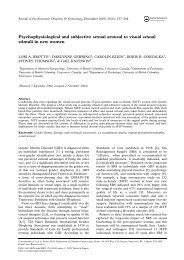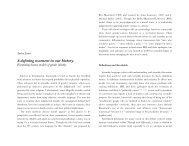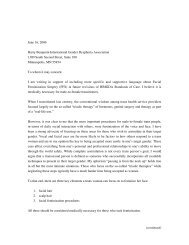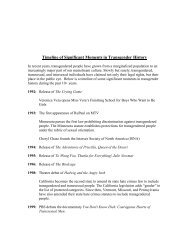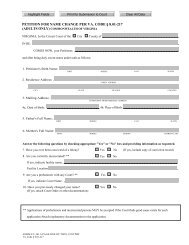Fair comment, foul play: - Transsexual Road Map
Fair comment, foul play: - Transsexual Road Map
Fair comment, foul play: - Transsexual Road Map
You also want an ePaper? Increase the reach of your titles
YUMPU automatically turns print PDFs into web optimized ePapers that Google loves.
<strong>Fair</strong> <strong>comment</strong>, <strong>foul</strong> <strong>play</strong>:<br />
Populist responses to J. Michael Bailey’s exploitative “controversies”<br />
Andrea James<br />
Part of the panel “The Bailey brouhaha: Community members<br />
speak out on resisting transphobia and sexism in academia and<br />
beyond”<br />
Joelle Ruby Ryan, moderator<br />
National Women’s Studies Association conference<br />
Cincinnati, Ohio<br />
June 21, 2008<br />
As is frequently the case in discussions that are conducted with a<br />
great show of emotion, the down-to-earth interests of certain<br />
groups, whose excitement is entirely concerned with factual<br />
matters and who therefore try to distort the facts, become quickly<br />
and inextricably involved with the untrammeled inspirations of<br />
intellectuals who, on the contrary, are not in the least interested in<br />
facts but treat them merely as a springboard for “ideas.”<br />
Hannah Arendt,<br />
Eichmann in Jerusalem: A Report on the Banality of Evil
Andrea James / <strong>Fair</strong> <strong>comment</strong>, <strong>foul</strong> <strong>play</strong> page 1<br />
Why the populist response?<br />
The “controversy” about J. Michael Bailey’s book is a marketing<br />
ploy by academic opportunists whose careers involve exploiting oppressed<br />
minorities. Bailey claims his book’s third section on transsexual taxonomy<br />
triggered the response, but he had published that material years earlier as<br />
“<strong>Transsexual</strong>ism: Women trapped in men’s bodies or men who would be<br />
women?” (Bailey 2000). His eventual title echoes that: The Man Who Would<br />
Be Queen (Bailey 2003a).<br />
Nobody went after Bailey when his work was first published. I<br />
myself sent a critical but civil note in May 2000 (James 2000). No one went<br />
after Bailey’s “sex science” colleagues for their “science” on trans women in<br />
previous decades. While those writings epitomize institutionalized<br />
transphobia (such as labeling trans women attracted to men “homosexual<br />
transsexuals” (Bagemihl 1997)), the authors generally remain academically<br />
responsible. Their true colors appear when popularizing their ideas, such as<br />
Ray Blanchard’s interview claiming a transsexual woman is merely “a man<br />
without a penis” (Armstrong 2004).<br />
The populist response to Bailey’s book in 2003 happened because<br />
1) it was fraudulently marketed as science by the National Academies<br />
of Science<br />
2) it became a cure narrative about gender-variant children<br />
National Academies member Lynn Conway helped coordinate the<br />
populist response, titling her work “An investigation into the publication of<br />
J. Michael Bailey's book on transsexualism by the National Academies”<br />
(Conway 2003). It wasn’t about Bailey’s third section, or Bailey’s ideas, or<br />
Bailey himself. It was about how this salacious bigotry got published by the<br />
National Academies of Science. It expanded because National Academies<br />
employees Stephen Mautner and Barbara Kline Pope never answered that<br />
question. Mautner even defended it as a “responsible work” (Mautner<br />
2003).<br />
Let’s examine Mautner’s outrageous claim. Let’s say your<br />
academic field comprises a pervasive stereotype about an oppressed<br />
minority; let’s say greediness in Jewish people. You and your colleagues<br />
have access to Jews through state-run programs which compel them to<br />
submit to your experiments. Historical examples abound, like the Tuskegee<br />
Study of Untreated Syphilis in the Negro Male (Heller 1972), or Robert<br />
Ritter’s work classifying the two types of “gypsies” for the Nazis (Willems<br />
1997). For trans people the historical example is Toronto’s Centre for<br />
Addiction and Mental Health (formerly the Clarke Institute), the source of<br />
much of the “science” Bailey alludes to in his book.<br />
Via state-funded experiments, your colleagues assert all Jews<br />
exhibit one of two types of greed: innate greed, or greed driven by fantasies<br />
of wealth and power. You write a book about it, including memorable<br />
anecdotes about greedy Jews you’ve met at pawn shops and brothels. You<br />
frame your book with a Jewish child you saw cured through therapy. You<br />
devise a test to tell the two types of greedy Jews apart. You claim a hallmark<br />
of Jewish greed is denial, so any greedy Jew who objects to your taxonomy<br />
National Women’s Studies Association panel: The Bailey Brouhaha
Andrea James / <strong>Fair</strong> <strong>comment</strong>, <strong>foul</strong> <strong>play</strong> page 2<br />
“proves” its validity. You quote eccentric Jewish people validated by your<br />
attention, who agree “most greedy Jews lie.”<br />
Stephen Mautner at the National Academies of Science arranges a<br />
secret “peer review” and you’re set. You title it The Jew in Jewelry: The Science<br />
of Judaism. Mautner’s team creates a cover depicting a hook-nosed figure<br />
clutching a wad of money. Barbara Kline Pope sends out press releases and<br />
puts the book online, and you get tenure.<br />
While that kind of <strong>foul</strong> <strong>play</strong> was certainly outrageous, what<br />
radicalized me was Bailey’s new framing device exploiting trans children<br />
(James 2003b). He compared his own children as the benchmark of<br />
normalcy (p. 52, p. 69). He also used his own children as evidence of his<br />
own normalcy: he calls himself a “single heterosexual man” (p. 141). He<br />
even dedicated his book to his children (p. v) and later trotted them out as<br />
evidence in the press (Wilson 2003).<br />
National Women’s Studies Association panel: The Bailey Brouhaha
Andrea James / <strong>Fair</strong> <strong>comment</strong>, <strong>foul</strong> <strong>play</strong> page 3<br />
Reparative therapy of gender-variant youth<br />
Bailey’s book is first and foremost a cure narrative framed by the<br />
story of “Danny Ryan,” a pseudonymous child dis<strong>play</strong>ing “gender<br />
nonconformity.” Bailey writes of Danny's mother, who has been frustrated<br />
by other therapists she has consulted about her son’s “feminine” behavior:<br />
“In spring of 1996 Leslie Ryan came to my Northwestern University office<br />
to seek yet another opinion” (p. 16).<br />
Bailey describes the “curing” of “Danny Ryan” after he explains to<br />
Danny’s mother about reparative therapy developed by his Toronto cronies<br />
(p. 3, p. 214). Bailey warns that a world tolerant of feminine boys might<br />
“come with the cost of more transsexual adults” (p. 30), noting Zucker<br />
thinks reparative therapy helps “reduce this risk” (p. 30). Bailey claims that<br />
Zucker considers transsexualism a “bad outcome” for children like Danny<br />
(p. 31). Zucker’s reparative therapy involves taking away anything<br />
“feminine” from the child (p. 31). Bailey notes, “learning more about the<br />
origins of transsexualism will not get us much closer to curing it” (p. 207).<br />
Danny’s “curing” is complete when Bailey runs into Danny on the<br />
last page of the book: “This was not a girl in boy’s clothing” (p. 214).<br />
Bailey’s last paragraph claims Danny asks to use the men's room. Bailey<br />
observes, “I am certain that as he said that, he emphasized ‘men’s’ and<br />
looked my way” (p. 214).<br />
cures “gender identity disorder,” not homosexuality. Zucker’s “problematic<br />
and harsh” (Lostracco 2008) reparative therapy is detailed in a 2008 NPR<br />
report: Zucker ordered a mother to take away her child’s “feminine” toys<br />
and ordered the child not to <strong>play</strong> with or even draw pictures of girls (Spiegel<br />
2008).<br />
The populist response to Zucker’s reparative therapy has been<br />
largely driven by the internet, the most significant advance for trans people<br />
that will happen in my lifetime. Our collected wisdom, once an oral<br />
tradition of drag mothers and pageant culture, a mish-mash of<br />
mimeographed pamphlets and clippings, mail-order newsletters, and<br />
answering machine recordings now has a permanent online home. Parents<br />
who once fought alone (Evelyn 1998) share alternatives to reparative<br />
therapy and refer families to supportive providers. Families are stepping<br />
forward as the public faces of gender-variant youth (TYFA 2008),<br />
organizing support groups and publicizing alternatives to Zucker’s<br />
reparative therapy (Brill 2008). We are in the midst of a paradigm shift as<br />
progressive providers really listen to the voice of the people and consider the<br />
true welfare of trans children.<br />
Clinicians compare Zucker’s efforts to “reparative therapy for<br />
homosexuals” (Pickstone-Taylor 2003), noting that reparative therapy<br />
“seeks to reverse sexual orientation or gender identification” (Dean 2000)<br />
[emphasis mine]. Zucker claims his “therapeutic intervention” is OK – he only<br />
National Women’s Studies Association panel: The Bailey Brouhaha
Andrea James / <strong>Fair</strong> <strong>comment</strong>, <strong>foul</strong> <strong>play</strong> page 4<br />
Academia as a tool of trans oppression<br />
Our populist uprising targets high-end academic research, which<br />
has become a corrupt, bloated money grab with almost no consequence if<br />
employees generate grant money and publicity. Bailey and colleagues like<br />
Alice Dreger exploit master narratives (Dreger 2008), consensus statements<br />
(ISNA 2006), college texts (LeVay 2007), and selective peer review (Mautner<br />
2003) to reinforce their views and dismiss differing views, especially from<br />
their objects of study. They turned the Archives of Sexual Behavior into the<br />
house organ and bully pulpit for knowledge produced by Toronto’s Centre<br />
for Addiction and Mental Health. They’ve also developed a highly effective<br />
strategy of using personal validation to exploit vulnerable individuals in<br />
oppressed communities. Following his exploitation of Anjelica Kieltyka (p.<br />
xii), Bailey continued with validation-craving eccentrics like Anne Lawrence<br />
(p. xii), Maxine Petersen (p. xii), and Alice Dreger (Dreger 2008), and in<br />
turn Dreger exploited Cheryl Chase (ISNA 2006) and Anjelica Kieltyka<br />
again (Dreger 2008). This tactic strengthens their credentialist positions as<br />
outsider experts, a feedback cycle of reciprocal validation from these<br />
grateful individuals.<br />
“Trolling” is internet slang for baiting people into a response.<br />
Online trolling is a highly developed subculture; academia and mainstream<br />
media have forms of trolling. Anne Coulter and Michael Moore turned<br />
trolling into entertainment. Trolls get money and publicity, and Bailey is a<br />
professional academic troll. His trolling template was the 1994 best-seller<br />
The Bell Curve, the “science” of racial differences in intelligence (Herrnstein<br />
1994). Janice Raymond’s transphobic troll The <strong>Transsexual</strong> Empire (Raymond<br />
1979) epitomizes an unanswered troll that took decades to undo. Academic<br />
trolls can’t lose. No response implies approval; any objection (however mild)<br />
becomes evidence they’re right.<br />
In 2003, Bailey called a mild rebuke from biologist Joan<br />
Roughgarden (Roughgarden 2003) “insulting and scathing” and<br />
characterized it as a “screed” (Bailey 2003b). By framing my non-academic<br />
response as a counter-troll, I deliberately shifted the “extreme” edge of the<br />
debate, moving formerly “radical” views to the moderate position. I have no<br />
interest whatsoever in having a “scientific” or “civil” debate about this book;<br />
that’s one way academic trolls try to control the debate. Academics tend to<br />
be very thin-skinned and self-important, so they’re easy to troll. The key to<br />
good trolling is getting them to do what you want while thinking it was their<br />
idea. Bailey and I are public figures, so pretty much anything said about us<br />
is fair <strong>comment</strong>. I wanted to echo Bailey’s disrespect, to bring consequence<br />
to his actions, since no academic consequence could be expected. I made it<br />
very clear this was the tipping point: a defining moment in our history<br />
(James 2004).<br />
Populist uprisings always use new media to great effect. The means<br />
of production and distribution of knowledge are no longer controlled by<br />
elites. Lynn Conway’s online investigation (Conway 2003) and my<br />
clearinghouse (James 2003a) had hundreds of contributors submitting<br />
thousands of items. In 2003 and 2004, it was everything we could do just to<br />
catalogue it all. The incident united the trans community as never before; a<br />
historically significant event (Surkan 2007). Academics attempting a feeble<br />
backlash against the Bailey backlash (Dreger 2008) are simply on the wrong<br />
side of history.<br />
National Women’s Studies Association panel: The Bailey Brouhaha
Andrea James / <strong>Fair</strong> <strong>comment</strong>, <strong>foul</strong> <strong>play</strong> page 5<br />
Reproduction and eugenics<br />
Freudian psychology is being supplanted by a “bio-psych merge”<br />
(Ordover 2003). Sociobiology, behavior genetics, and evolutionary<br />
psychology all try to graft science onto social constructions, like “social<br />
Darwinism” and eugenics before them.<br />
In Bailey’s evolutionary psychology, “homosexuality might be the<br />
most striking unresolved paradox of human evolution.” Because he believes<br />
“the number of healthy offspring one leaves is perhaps the best indicator of<br />
evolutionary success” (p. 116), Bailey frames his book within this essentialist<br />
discourse, where homosexuality is “maladaptive” (p. 116) in terms of<br />
evolution. Most people see “race science” as hopelessly biased<br />
pseudoscience, but most don’t see similarities between “sex science” and<br />
“race science” yet. In fact, many LGBT people have faith that their political<br />
salvation lies in “sex science” (Ordover 2003). Being labeled distinct,<br />
disordered, and diseased may rescue them from the “sin” and “lifestyle<br />
choice” arguments, but at what cost?<br />
Conservatives hate the populist phrase “it takes a village to raise a<br />
child.” It takes a family to raise a child, they counter. Zucker blames<br />
childhood gender identity disorder on poor family dynamics and “maternal<br />
psychopathology” (Zucker 2002). Bailey, Lawrence, and Dreger obliquely<br />
assert their worth or fitness is evidenced by being breeding organisms.<br />
Bailey talks about screening for and aborting gay fetuses as a “parental<br />
right” (Greenberg 2001), hinting that the next wave of eugenics will occur in<br />
utero. The “parental rights” movement can be better thought of as distributed<br />
eugenics. One way to stop distributed eugenics is through populism, by<br />
helping regular people understand that individual choices affect the whole<br />
population and vice versa.<br />
This controversy boils down to reproduction, specifically natural<br />
selection. Essentially (in every sense of that word), the controversy is about<br />
the eugenic ideology of the “unfit.” “Gender identity disorder” and<br />
“disorders of sex development” are eugenic heterosexism. Bailey thinks<br />
homosexuality may represent a “developmental error” (Bailey 1999).<br />
Blanchard thinks “nonhomosexual” transsexualism is a paraphilic “defect in<br />
a man’s sexual learning” (Blanchard 1991), echoing his mentor Freund’s<br />
“courtship disorders” (Freund 1983). The order to which eugenicists ascribe<br />
asserts that the purpose or function of life is to make more life, or more<br />
specifically, “better” life.<br />
National Women’s Studies Association panel: The Bailey Brouhaha
Andrea James / <strong>Fair</strong> <strong>comment</strong>, <strong>foul</strong> <strong>play</strong> page 6<br />
Conclusion<br />
Bailey’s book is a self-aggrandizing exercise in identity politics,<br />
where he’s a heroic scientist who is “curing” gender-variant children and<br />
speaking “scientific truth” despite “hysterical” activists whose “identity<br />
politics” and “narcissistic” rage drive their efforts to “ruin” him (Bailey<br />
2003c). Bailey outlines transsexuals’ “common lies and deceptiveness” (p.<br />
232) and explains away those who take issue with his claims as inept (p.<br />
176), mentally disordered (Dreier 2003), or lying (Krasny 2007).<br />
But that’s not the real story. Essentially, Bailey’s book argues that<br />
he is a “single heterosexual man” (p. 141). He throws around the phrase<br />
“gay, straight, or lying” (p. 96, p. 133) because he hates sexologist John<br />
Money’s book Gay, Straight, and In-Between (Money 1990). By replacing “inbetween”<br />
with “lying,” Bailey erases his bisexual and trans critics and extols<br />
his “open and honest” supporters of the “male essence” narrative.<br />
(Wyndzen 2008). Yet Bailey isn’t open and honest about his own sexual<br />
interests: “Everything that I’m willing to say about my personal life, I’ve<br />
already said” (Krasny 2007). For more on this hypocrisy, see my essay<br />
“Gay, Straight, or Bailey” (James 2003c). Bailey is only attracted to<br />
“homosexual transsexuals” who are “naturally feminine” (p. 168): “If a gay<br />
man wants to attract straight men, he should imitate a woman” (p. 138).<br />
Blanchard appeals to Bailey because transfans like Bailey “are not gay but<br />
are more like ‘scrambled up heterosexual men’” (p. 187). Blanchard’s<br />
taxonomy (and thus Bailey’s book) also affirms Anne Lawrence’s selfidentity<br />
as a “real” transsexual (Lawrence 1998) rather than a nontranssexual<br />
under other taxonomies (Lawrence 2001). Bailey, Blanchard,<br />
and Lawrence are locked a feedback loop of personal and professional<br />
validation with like-minded supporters.<br />
In my opinion, Bailey’s fraud extends beyond marketing this<br />
“controversy” as science. Bailey’s “Ryan” family is too perfect, embodying<br />
every element needed for Bailey to refute opponents, all in one convenient<br />
family. “Danny Ryan” would be an adult now, so I imagine a disinterested<br />
party will soon independently determine if “Danny” exists.<br />
Bailey’s “controversy” was countered by a populist response that<br />
exposed his indefensible actions. He unwittingly started an unstoppable<br />
populist movement which still amazes me daily. It evokes a passage from<br />
Maya Angelou (Angelou 1978) that I first read in Les Feinberg’s Transgender<br />
Warriors (Feinberg 1996):<br />
You may write me down in history<br />
With your bitter, twisted lies,<br />
You may trod me in the very dirt<br />
But still, like dust, I'll rise.<br />
National Women’s Studies Association panel: The Bailey Brouhaha
Andrea James / <strong>Fair</strong> <strong>comment</strong>, <strong>foul</strong> <strong>play</strong> page 7<br />
References<br />
Parenthetical page numbers in the article refer to Bailey’s The Man<br />
Who Would Be Queen and are quoted in Appendix 1.<br />
Angelou, Maya (1978). Still I Rise. And Still I Rise. Random House.<br />
Arendt, Hannah (1963). Eichmann in Jerusalem: A Report on the Banality of Evil.<br />
Reprint 1992, Penguin Classics.<br />
Armstrong, Jane (2004). The body within: The body without. The Globe and<br />
Mail, June 12.<br />
Toronto psychologist Ray Blanchard, one of Canada's leading -- and most<br />
controversial -- gender experts, argues the transgendered movement is rife<br />
with delusion. "This is not waving a magic wand and a man becomes a<br />
woman and vice versa," he says. "It's something that has to be taken very<br />
seriously. A man without a penis has certain disadvantages in this world,<br />
and this is in reality what you're creating."<br />
Bagemihl, Bruce (1997). Surrogate phonology and transsexual faggotry: A<br />
linguistic analogy for uncoupling sexual orientation from gender identity. In<br />
Queerly Phrased: Language, Gender, and Sexuality. Anna Livia, Kira Hall (eds.) pp.<br />
380 ff. Oxford University Press.<br />
A particularly revealing example of the heterosexist and generally biased<br />
reasoning of medical professionals can be found in the language used to<br />
categorize and pathologize transsexuality. Clinical studies and definitions<br />
have traditionally employed a confusing terminology in which, for<br />
example, a female-to-male transsexual how is attracted to women is<br />
labeled a "homosexual transsexual," while a female-to-male transsexual<br />
who is attracted to men is labeled a "heterosexual transsexual." In other<br />
words, the point of reference for "heterosexual" or "homosexual"<br />
orientation in this nomenclature is solely the individual's genetic sex prior<br />
to reassignment (see for example, Blanchard et al. 1987, Coleman and<br />
Bockting, 1988, Blanchard, 1989). These labels thereby ignore the<br />
individual’s personal sense of gender identity taking precedence over<br />
biological sex, rather than the other way around. With this clinical<br />
terminology, people can be conveniently described as "escaping" a<br />
stigmatized homosexual identity when they become involved with<br />
members of the opposite sex following reassignment (erroneously assumed<br />
to be “the norm”). The myth of the heterosexual imperative and the<br />
primacy of biology is thereby reasserted and rebuttressed, while the<br />
transgressive status of all transsexuals is trivialized.<br />
Bailey, J. Michael (1999). Commentary: Homosexuality and mental illness,<br />
Archives of General Psychiatry, October, vol. 56, no. 10, 876-880.<br />
Bailey, J. Michael (2000). <strong>Transsexual</strong>ism: Women trapped in men’s bodies<br />
or men who would be women?<br />
http://web.archive.org/web/*/http://www.psych.nwu.edu/psych/people<br />
/faculty/bailey/transsexualism.html<br />
Bailey, J. Michael (2003a). The Man Who Would Be Queen: The Science of Gender-<br />
Bending and <strong>Transsexual</strong>ism. National Academies/Joseph Henry Press.<br />
See Appendix 1 for cited quotations.<br />
Bailey, J. Michael (2003b). Book controversy question & answer.<br />
http://www.psych.northwestern.edu/psych/people/faculty/bailey/controv<br />
ersy.htm<br />
Bailey, J. Michael (2003c). Identity politics as a hindrance to scientific truth.<br />
Paper presented at International Academy of Sex Research conference, July<br />
19.<br />
Blanchard, Ray (1991). Clinical observations and systematic studies of<br />
autogynephilia. Journal of Sex and Marital Therapy, 17(4), 235-251.<br />
Brill, Stephanie and Rachel Pepper (2008). The Transgender Child. Cleis Press.<br />
National Women’s Studies Association panel: The Bailey Brouhaha
Andrea James / <strong>Fair</strong> <strong>comment</strong>, <strong>foul</strong> <strong>play</strong> page 8<br />
Conway, Lynn (2003). An investigation into the publication of J. Michael<br />
Bailey's book on transsexualism by the National Academies.<br />
http://ai.eecs.umich.edu/people/conway/TS/LynnsReviewOfBaileysBook<br />
.html<br />
Dean, Laura, et al. (2000). Lesbian, gay, bisexual, and transgender health:<br />
Findings and concerns. Journal of the Gay and Lesbian Medical Association, 2000.<br />
Dreger, Alice (2008). The controversy surrounding The Man Who Would Be<br />
Queen: A case history of the politics of science, identity, and sex in the<br />
internet age. Archives of Sexual Behavior. 37:3, pp. 366-421.<br />
Dreier, Sarah and Kevin Anderson (2003). Prof's book challenges opinions<br />
of human sexuality. Daily Northwestern, April 21.<br />
“A lot of people think there is something weird about (being an<br />
autogynepheliac) and it is a narcissistic blow,” Bailey said. “I am very<br />
sympathetic to transsexuals. I like these people, except for the people who<br />
hate me -- they scare me. […] I am not rejecting the claims (of<br />
transsexuals) for no reason,” he said. “There is good scientific research<br />
that says you should believe me and not them.”<br />
Evelyn, Just (1998). Mom, I need to be a girl. Walter Trook Publishing.<br />
Feinberg, Leslie (1996). Transgender Warriors: Making History from Joan of Arc to<br />
Dennis Rodman. Beacon Press.<br />
Freund, Kurt, et al. (1983). The courtship disorders. Archives of Sexual<br />
Behavior, 12:369-79.<br />
Hill, Darryl B., et al. (2006). Gender Identity Disorders in Childhood and<br />
Adolescence: A Critical Inquiry. pp. 7-34. In Dan Karasic and Jack<br />
Drescher (Eds.) Sexual and Gender Diagnoses of the Diagnostic and Statistical Manual<br />
(DSM): A Reevaluation. Haworth Press.<br />
Zucker and Bradley believe that reparative treatments (encouraging the<br />
child to accept their natal sex and associated gender) can be therapeutic<br />
for several reasons. They believe that treatment can reduce social<br />
ostracism by helping gender non-conforming children mix more readily<br />
with same sex peers and prevent long-term psychopathological<br />
development (1.e., it is easier to change a child than a society intolerant of<br />
gender diversity). Reparative therapy is believed to reduce the chances of<br />
adult GID (i.e., transsexualism) which Zucker and Bradley characterize as<br />
undesirable. Thus, “nipping” gender disorder “in the bud” holds a<br />
promise of an easier life for the child in adulthood, something that<br />
resonates with some parents.<br />
Intersex Society of North America (2006). Consortium on Disorders of Sex<br />
Development.<br />
http://www.dsdguidelines.org/<br />
James, Andrea (2000). Internet article on transsexualism. Personal email to<br />
J. Michael Bailey, May 3.<br />
James, Andrea (2003a). Categorically wrong? A Bailey-Blanchard-Lawrence<br />
clearinghouse. <strong>Transsexual</strong> <strong>Road</strong> <strong>Map</strong>.<br />
http://www.tsroadmap.com/info/bailey-blanchard-lawrence.html<br />
Greenberg, Aaron, and J. Michael Bailey (2001). Parental selection of<br />
children's sexual orientation. Archives of Sexual Behavior. Aug;30(4):423-37;<br />
discussion 439-41.<br />
Heller, Jean (1972). "Syphilis Victims in the U.S. Study Went Untreated for<br />
40 Years" (Associated Press), New York Times, July 26, 1972: 1, 8.<br />
Herrnstein, Richard, and Charles Murray (1994). The Bell Curve: Intelligence<br />
and Class Structure in American Life. Free Press.<br />
National Women’s Studies Association panel: The Bailey Brouhaha
Andrea James / <strong>Fair</strong> <strong>comment</strong>, <strong>foul</strong> <strong>play</strong> page 9<br />
James, Andrea (2003b). Need your number. Personal email to Anne<br />
Lawrence, April 18.<br />
When criticized for a deliberately offensive satire including Bailey’s kids, I<br />
replied, “It's how he's treating my kids.”<br />
James Andrea (2003c). Gay, straight, or Bailey: J. Michael Bailey’s very<br />
personal crusade against bisexuality. <strong>Transsexual</strong> <strong>Road</strong> <strong>Map</strong>.<br />
http://www.tsroadmap.com/info/bailey-bisexual.html<br />
James, Andrea (2004). A defining moment in our history: Examining disease<br />
models of gender variance. <strong>Transsexual</strong> <strong>Road</strong> <strong>Map</strong>. Reprinted in Transgender<br />
Tapestry issue 110, 2006.<br />
http://www.tsroadmap.com/info/gender-identity.html<br />
Krasny, Stuart (2007). "Transgender Theories." Forum with host Michael<br />
Krasny, KQED 22 August.<br />
http://www.tsroadmap.com/info/alice-dreger/bailey-kqed.html<br />
Bailey: “I… Not only does ‘Danny’ exist, but I am… I have several<br />
informants who keep me apprised of his development, and now he’s a<br />
happy, out gay man, as I predicted in the book. And I would say that both<br />
the critics in the studio there, either have not read my book, or they are<br />
lying about it.<br />
Bailey: You know, I don’t see how this campaign of defamation requires<br />
me to open up my entire personal life to everybody, so—<br />
Bailey: Everything that I’m willing to say about my personal life I’ve<br />
already said, and you should probably be asking Alice Dreger…<br />
Lawrence, Anne (1998). “Men trapped in men’s bodies:” An introduction to<br />
the concept of autogynephilia.<br />
http://home.swipnet.se/~w-13968/autogynephilia.html<br />
Among transsexuals, autogynephilia is not quite respectable as a topic for<br />
discussion. For one thing, many transsexuals have a passionate dislike for<br />
the Clarke Institute, and tend to dismiss out of hand any findings that have<br />
come from it. Therefore Blanchard's ideas are not often talked about; and<br />
when they are raised, they tend to get shouted down. Shame is<br />
undoubtedly another deterrent. It is probably just too threatening for<br />
many transsexuals to admit that they have had autogynephilic fantasies,<br />
and especially to admit that autogynephilic sexual desire may have been<br />
one of their motivations for seeking sex reassignment surgery. People are<br />
understandably reluctant to admit to having a paraphilia -- more<br />
popularly known as a perversion. Most transsexual women want to be seen<br />
as a “real women,” and it is widely understood that paraphilic arousal is<br />
almost exclusively confined to men. <strong>Transsexual</strong>s who admit to<br />
autogynephilic arousal may not be seen as “real women” -- and may not<br />
even be seen as “real” transsexuals!<br />
Lawrence, Anne, and Sember R (2001). Not to cure: A conversation about<br />
health, gender and sexuality. Journal of the Gay and Lesbian Medical Association,<br />
Volume 5, Number 1, March 2001, pp. 27-29(3).<br />
“When I deliberately reach for a sexually exciting image, I often think<br />
back to myself as a gender dysphoric adolescent, and the most sexually<br />
exciting thing I can imagine is the possibility of transforming my body at<br />
that young age.”<br />
[author’s <strong>comment</strong>: That doesn’t sound like Blanchard’s “misdirected heterosexuality,” it<br />
sounds like redirected pedophilia.]<br />
National Women’s Studies Association panel: The Bailey Brouhaha
Andrea James / <strong>Fair</strong> <strong>comment</strong>, <strong>foul</strong> <strong>play</strong> page 10<br />
LeVay, Simon, and Sharon Valente (2003). Human Sexuality. Sinauer.<br />
Lostracco, Marc (2008). But for today I am a boy. Torontoist, May 9.<br />
http://torontoist.com/2008/05/but_for_today_i_am_a_boy.php<br />
Mautner, Stephen (2003). [Untitled open letter], June 24.<br />
http://www.tsroadmap.com/info/stephen-mautner.pdf<br />
The Joseph Henry Press (JHP), publisher of Bailey’s book, is an imprint of<br />
the National Academies Press engaged in publishing books on science,<br />
engineering, and medicine for popular audiences. JHP books are<br />
individually authored works, each carrying a notice that the opinions<br />
expressed are solely the author’s and do not necessarily reflect the views of<br />
the National Academies. JHP follows clear decision rules for selecting<br />
books for publication and for scientific review of manuscripts. The work in<br />
question was reviewed as a well-crafted and responsible work on a difficult<br />
topic, reflecting one approach to a legitimate avenue of scholarship and<br />
research.<br />
Money, John (1990). Gay, Straight and In-Between: The Sexology of Erotic<br />
Orientation. Oxford University Press.<br />
Ordover, Nancy (2003). American Eugenics: Race, Queer Anatomy, and the Science<br />
of Nationalism. University of Minnesota Press.<br />
Pickstone-Taylor, S.D. (2003). Children with gender nonconformity. Journal<br />
of the American Academy of Child and Adolescent Psychiatry, 42, 266.<br />
Raymond, Janice (1979, reprint 1994). The <strong>Transsexual</strong> Empire: The Making of<br />
the She-Male. Teachers College, Columbia University, New York.<br />
Roughgarden, Joan (2003). Psychology lecture lacks sensitivity to sexual<br />
orientation. The Stanford Daily, April 25.<br />
http://daily.stanford.edu/article/2003/4/25/psychologyLectureLacksSensitivityToSexualOrientation<br />
Bailey was introduced as “controversial,” someone whose work has<br />
important implications for law, medicine and social policy and as a<br />
successful teacher whose courses feature “<strong>Transsexual</strong>s stripping after<br />
class.” (First big laugh.) The initial photographs included a male-bodied<br />
child wearing her mother’s shoes, when the second round of laughter<br />
erupted. A female-bodied child was then shown in male clothes and<br />
quoted as saying she “wanted a penis,” again producing laughter. In<br />
another example, an older child in a clinical setting was given the choice of<br />
toys and chose a doll and a wig. She was quoted as saying, “I hate my<br />
hair,” greatly amusing the audience.<br />
Roughgarden, Joan (2004). The Bailey affair: Psychology perverted.<br />
http://ai.eecs.umich.edu/people/conway/TS/Reviews/Psychology%20Pe<br />
rverted%20%20by%20Joan%20Roughgarden.htm<br />
Spiegel, Alix (2008). Two families grapple with sons’ gender preferences. All<br />
Things Considered, NPR, May 7.<br />
http://www.npr.org/templates/story/story.php?storyId=90247842<br />
Surkan, K. (2007). <strong>Transsexual</strong>s Protest Academic Exploitation. In Lillian<br />
Faderman, Yolanda Retter, Horacio Roque Ramírez, eds. ''Great Events<br />
From History: Gay, Lesbian, Bisexual, Transgender Events, 1848-2006.''<br />
pages 111-114. Salem Press<br />
TransYouth Family Allies [TYFA] (2008). Education through<br />
understanding: A guide for supporting transyouth and their families.<br />
Willems, Wim (1997). [Don Bloch translation]. In Search of the True Gypsy:<br />
From Enlightenment to Final Solution. Routledge. See chapter 5, Robert Ritter<br />
(1901-51): eugenist and criminological biologist, pp. 196 ff, and Annex 5<br />
and 6 summarizing Ritter’s work in defining “gypsies” into two types.<br />
Wilson, Robin (2003). ‘Dr. Sex.’ Chronicles of Higher Education. June 20, 2003.<br />
http://chronicle.com/free/v49/i41/41a00801.htm<br />
Wyndzen, Madeline H. (2008). A social psychology of a history of a snippet<br />
in the psychology of transgenderism. Archives of Sexual Behavior. 37:3, pp. 498-<br />
502.<br />
Zucker, Kenneth J. et al. (2002). Gender-dysphoric children and adolescents:<br />
A comparative analysis of demographic characteristics and behavioral<br />
problems. Clinical Child Psychology and Psychiatry, Vol. 7, No. 3, 398-411.<br />
National Women’s Studies Association panel: The Bailey Brouhaha
Andrea James / <strong>Fair</strong> <strong>comment</strong>, <strong>foul</strong> <strong>play</strong> page 11<br />
Appendix 1: Cited passages from The Man Who Would Be Queen<br />
v<br />
For Drew/Kate<br />
[author <strong>comment</strong>: Bailey renders his children’s names as if dedicating this<br />
to one (trans) person who uses both a male and a female name]<br />
3 After Danny Ryan became a proficient walker, not much more than<br />
a year old, he ventured into his mom’s closet. He came out with a<br />
pair of strappy heels and struggled to put them on.<br />
16 In the spring of 1996 Leslie Ryan came to my Northwestern<br />
University office to seek yet another opinion. Jennifer, Danny’s sitter,<br />
was a student in my human sexuality class and was working in my<br />
laboratory on studies of sexual orientation.<br />
30 [Kenneth] Zucker thinks that an important goal of treatment is to<br />
help the children accept their birth sex and to avoid becoming<br />
transsexual. His experience has convinced him that if a boy with GID<br />
becomes an adolescent with GID, the chances that he will become an<br />
adult with GID and seek a sex change are much higher. And he<br />
thinks that the kind of therapy he practices helps reduce this risk.<br />
31 The central difference between Zucker and his critics on the left is<br />
that Zucker believes that most boys who <strong>play</strong> with girls’ things often<br />
enough to earn a diagnosis of GID would become girls if they could.<br />
Failure to intervene increases the chances of transsexualism in<br />
adulthood, which Zucker considers a bad outcome.<br />
52 I think of my own daughter and cannot imagine her deciding to be a<br />
boy, even if I lied to her and told her that she was born one.<br />
69 My son was 10 years old when we began our dance study. One day I<br />
explained what we were studying, and I asked him why I might<br />
expect to find a high rate of gay male dancers. He immediately<br />
answered, “Because dancing is feminine, and gay men tend to be<br />
feminine.” I was pleased by his answer, which was also mine.<br />
69 Another anecdote involving my son:<br />
70 When he was 10 years old, we were sitting in a theater waiting for the<br />
movie to start. A man behind us was speaking, and my son leaned<br />
over and said, “Dad, there’s someone for you to study.” My son<br />
knows that I study sexual orientation, and this was his way of<br />
suggesting that the man sounded gay.<br />
75 Although their data are less scientific, gay men share [Kurt] Freund’s<br />
skepticism. They have a saying:<br />
76 “You’re either gay, straight, or lying.” In contrast, many women are<br />
bisexual; perhaps most are, at least in their sexual arousal patterns.<br />
116 Heterosexuality is a paradigmatic evolutionary adaptation. The<br />
desire to have sex with members of the opposite sex helps people<br />
have sex that might result in offspring. The number of healthy<br />
offspring one leaves is perhaps the best indicator of evolutionary<br />
success.<br />
Homosexuality is evolutionarily maladaptive. I think this is an<br />
undeniable fact, although gay-positive people (and I am one) tend to<br />
cringe when they hear words like these. “Evolutionarily maladaptive”<br />
sounds like an insult, but it isn’t one.<br />
133 Recall gay men’s skepticism about men who claim to be bisexual.<br />
(“You’re either gay, straight, or lying.”) My lab has been trying to<br />
find bisexual men by studying men’s erections to male versus female<br />
sexual stimuli.<br />
138 If a gay man wants to attract straight men, he should imitate a<br />
woman. If he wants to attract gay men, he must stay a man.<br />
141 I see Kim for the first time, on the stairs, dancing, posing. She is<br />
spectacular, exotic (I find out later that she is from Belize), and sexy.<br />
[…] It is difficult to avoid viewing Kim from two perspectives: as a<br />
researcher but also as a single, heterosexual man.<br />
National Women’s Studies Association panel: The Bailey Brouhaha
Andrea James / <strong>Fair</strong> <strong>comment</strong>, <strong>foul</strong> <strong>play</strong> page 12<br />
168 Autogynephiles are not “women trapped in men’s bodies.” (Anne<br />
Lawrence, a physician and sex researcher who is herself a<br />
postoperative transsexual, has called them “men trapped in men’s<br />
bodies.”) Homosexual transsexuals, so naturally feminine from early<br />
on, can make this claim more accurately, but as we shall see, it is not<br />
completely true even of them.<br />
176 [Ray] Blanchard’s ideas have not yet received the widespread<br />
attention they deserve, in large part because sex researchers are not<br />
as scholarly as they should be and so don’t read the current scientific<br />
journals.<br />
unusual, for an eight-year-old boy, and his speech style was precise<br />
and somewhat prissy. This was not a typical boy, either.<br />
A few moments later, Danny said: “Mummy, I need to go to the<br />
men’s room.” I am certain that as he said that, he emphasized<br />
“men’s” and looked my way. And off he went, by himself. At that<br />
moment, I became as certain as I can be of Danny’s future.<br />
232 [from the Index]<br />
<strong>Transsexual</strong>s<br />
Common lies and deceptiveness of, 172-176<br />
187 Blanchard thinks that a significant number of men who want shemales<br />
are “partial autogynephiles”—they are primarily aroused to<br />
the image of themselves as she- male. Blanchard says that the men<br />
are not gay but are more like “scrambled up heterosexual men.” The<br />
transsexuals I know who worked as she-male prostitutes confirmed<br />
this. “There was nothing gay about those men,” said one, who knows<br />
plenty about gay men.<br />
207 One problem with [Paul] McHugh’s analysis is that we simply have<br />
no idea how to make gender dysphoria go away. I suspect that both<br />
autogynephilic and homosexual gender dysphoria result from early<br />
and irreversible developmental processes in the brain. If so, learning<br />
more about the origins of transsexualism will not get us much closer<br />
to curing it.<br />
214 Looking at Danny, it was difficult to imagine him wearing high heels<br />
and a dress. He looked good as a boy—if an unusually formally<br />
dressed one. When the family friend’s daughter showed up, she told<br />
him how handsome he looked, and he beamed. This was not a girl in<br />
boy’s clothing.<br />
As we congregated in the hallway, I watched Danny interact. Shy at<br />
first, he whispered quietly to his sister. Then someone asked him<br />
about Convocation. He cocked his head back dramatically, threw his<br />
forearm across his eyes and said, “I thought it was entirely too long.<br />
Must they read every single name?” His word choice was obviously<br />
National Women’s Studies Association panel: The Bailey Brouhaha


